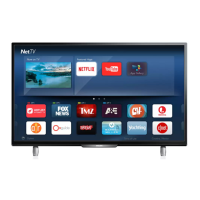Service Modes and Fault Finding
EN 34 TPN15.1E LA5.
2015-Oct-30
back to
div. table
How to Exit the Factory mode
Use one of the following methods:
• Select EXIT_FACTORY from the menu and press the “OK”
button.
Note: When the TV is switched “off” by a power interrupt, or
normal switch to “stand-by” while in the factory mode, the TV
will show up in “normal operation mode” as soon as the power
is supplied again. The error buffer will not be cleared.
5.2.5 Customer Service Mode (CSM)
Purpose
The Customer Service Mode shows information on the TVs
operation settings.The call centre can instruct the customer (by
telephone) to enter CSM in order to identify the status of the
set.This helps the call centre to diagnose problems and failures
in the TV set before making a service call.
The CSM is a read-only mode; therefore, modifications are not
possible in this mode.
Specifications
• Ignore “Service unfriendly modes”.
• Line number for every
line (to make CSM language independent).
• Set the screen mode to full
screen (all contents on screen is visible).
• After leaving the Customer Service Mode, the original
settings are restored.
• Possibility to use “CH+” or “CH-” for channel surfing, or
enter the specific channel number on the RC.
How to Activate CSM
To activate CSM, press the following key sequence on a
standard remote control transmitter: “123654” (do not allow the
display to time out between entries while keying the sequence).
After entering the Customer Service Mode, the following items
are displayed.
Note: Activation of the CSM is only possible if there is no (user)
menu on the screen!
Contents of CSM
• 1.1 Set Type This information is very helpful for a
helpdesk/workshop as reference for further diagnosis. In
this way, it is not necessary for the customer to look at the
rear of the TV-set. Note that if an NVM is replaced or is
initialized after corruption, this set type has to be re-written
to NVM.
• 1.2 Production code Displays the production
code (the serial number) of the TV. Note that if an NVM is
replaced or is initialized after corruption, this production
code has to be re-written to NVM.
• 1.3 Installation date Indicates the date of the first
installation of the TV. This date is acquired via time
extraction.
• 1.4 SSB Gives an identification of the SSB as stored in
NVM. Note that if an NVM is replaced or is initialized after
corruption, this identification number has to be re-written to
NVM. This identification number is the 12NC number of the
SSB.
• 1.5 Display 12NC NVM read/write.
• 1.6 PSU 12NC NVM read/write.
• 2.1 Current Main SW Displays the built-in main software
version. In case of field problems related to software,
software can be upgraded. As this software is consumer
upgradeable, it will also be published on the internet.
• 2.2 Standby SW Displays the built-in stand-by processor
software version. Upgrading this software will be possible
via USB.
• 2.3 Panel Code Displays the Display Code number.
• 2.4 NVM version Detects and displays NVM version.
• 3.1 Signal Quality Analog/digital signal strength.
• 3.2 Child lock Not active / active. This is a combined item
for locks. If any lock (channel lock, parental lock) is active,
it is indicated as “active”.
•
3.3 HDCP keys Ind
icates the validity of the HDMI keys (or
HDCP keys). In case these keys are not valid and the
customer wants to make use of the HDMI functionality, the
SSB has to be replaced.
How to Navigate
By means of the “CURSOR-DOWN/UP” knob (or the scroll
wheel) on the RC-transmitter, can be navigated through the
menus.
How to Exit CSM
To exit CSM, use one of the following methods.
• Press the MENU/HOME button on the remote control
transmitter.
• Press the POWER button on the remote control
transmitter.
• Press the POWER button on the television set.
45LVDS Driving 3333333LVDS Driving
46 LVDS Format VESA
8bit
JEIDA
8bit
VESA
8bit
JEIDA
8bit
VESA
8bit
NS 10bit NS 10bit LVDS Format
47 Ziggo Aging Press OK Ziggo Aging
48 SPDIF On Enable/Disable SPDIF source
49 Standard PWM Gain 100 100 100 100 100 100 100 Standard PWM Gain
50 ECO PWM Gain 100 100 100 100 100 100 100 ECO PWM Gain
51 VGA port on On Off Off Off Off Off Enable/Disable VGA port
52 Zero Detect Enable on On On On On On On Zero Detect Enable
53 Copy PQ table to TV Press OK Copy PQ table to TV
54 Copy AQ table to TV Press OK Copy AQ table to TV
55 Headphone on On On On On On On Enable/Disable Headphone source
56 EnhancedH/88 on On On On On On On EnhancedH/88
57 Joysticker Enable Off Off On On On On On Joysticker Enable
58 Ambilight Enable Off Off Off Off Off On On Ambilight Enable
59 Lounge Light Enable Off Off Off Off Off On Off Lounge Light Enable
60 FRC F/W Upgrade Press OK FRC F/W Upgrade
61 TUNERADDR 0xC4 TUNER Address
62912_SSC_LVDS_PERCENT000003030Percent of 912_SSC_LVDS
63912_SSC_LVDS_FREQ000002020912_SSC_LVDS_FREQ
64912_LVDS_DRIVING 000002015912_LVDS_DRIVING
65 912_LVDS_FORMAT JEDIA
8bit
JEDIA
8bit
JEDIA
8bit
JEDIA
8bit
JEDIA
8bit
JEDIA
10bit
JEDIA
10bit
The format for 912_LVDS
66 EXIF_FACTORY Press OK Exits the Factory mode
Item Item value
Default value
Description22" 24" 32" 39" 40" 48" 55"

